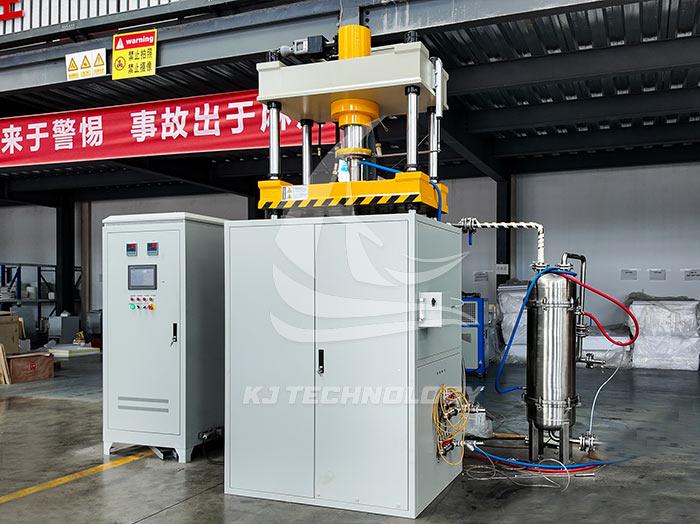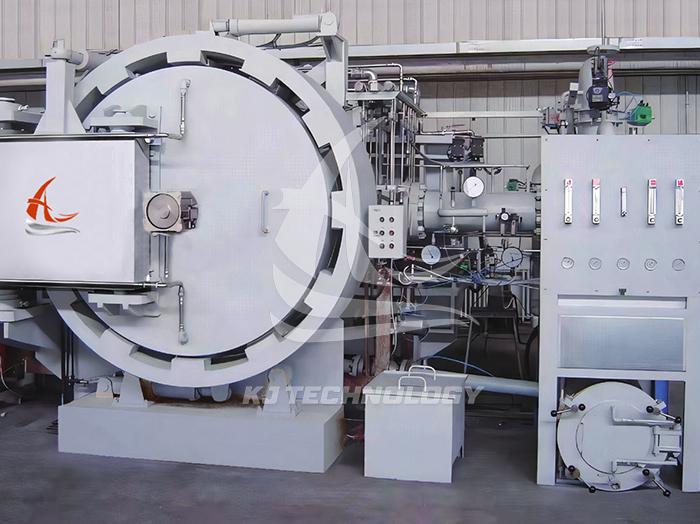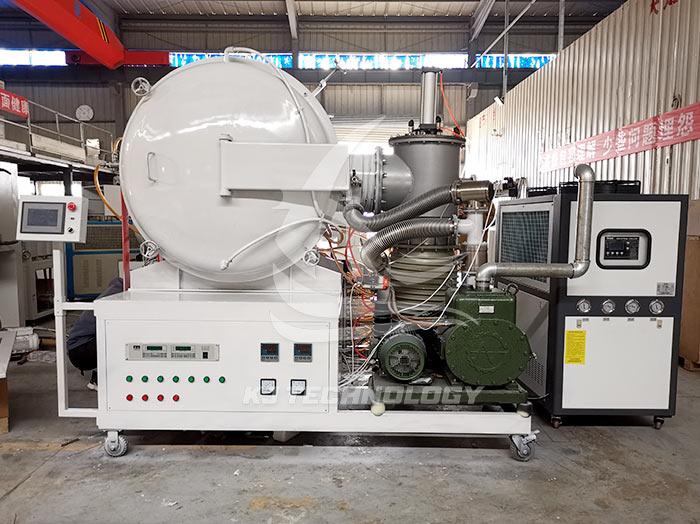Vacuum hot pressing furnace
 07-07-2025 Author: KJ technology
07-07-2025 Author: KJ technology
A vacuum hot press furnace is a device that achieves material densification, sintering, or hot pressing through the synergistic effect of high-temperature heating and mechanical pressure in a vacuum or inert gas protected environment.
1. Core Definition and Working Principle
A vacuum hot press furnace is a device that achieves material densification, sintering, or hot pressing through the synergistic effect of high-temperature heating and mechanical pressure in a vacuum or inert gas protected environment. The core principle is:
High temperature environment: By using resistance heating (such as graphite or molybdenum wire heating elements) or induction heating, the temperature inside the furnace is raised to 800-2000 ℃, softening the material particles.
Mechanical pressurization: The hydraulic system drives the pressure head (bi-directional pressurization) to apply pressure (adjustable from 10-100 tons) to the material, promoting metallurgical bonding between particles and eliminating pores.
Vacuum/atmosphere control: The vacuum system (oil diffusion pump+mechanical pump) pumps the pressure inside the furnace to ≤ 10 ⁻ Pa to avoid oxidation; The inflation system can be filled with protective gases such as nitrogen and argon to meet different material requirements.
Typical application scenarios:
Hard alloy: tungsten cobalt cutting tool materials are sintered, with a density increased to ≥ 99.5%.
Functional ceramics: densification of transparent ceramics (such as Al ₂ O ∝, YAG) with a light transmittance of ≥ 85%.
Powder metallurgy: sintering of titanium alloy and high-temperature alloy billets to achieve a density of ≥ 99%.
Composite materials: High temperature sintering of silicon carbide (SiC) and silicon nitride (Si3N4) ceramics, with a bending strength of ≥ 800 MPa.
2. System composition and key technologies
Furnace structure
Double layer water-cooled jacket: The inner layer is made of 304 stainless steel (high temperature resistant and corrosion-resistant), and the outer layer is made of carbon steel. The furnace shell is protected by circulating water cooling.
Vertical/horizontal design: The vertical furnace body is convenient for the vertical pressure head to apply pressure, while the horizontal design is suitable for processing long and rectangular workpieces (such as pipes).
Heating system
Graphite resistance heating: with a maximum temperature of 2000 ℃, suitable for high-temperature ceramic sintering.
Molybdenum wire heating element: temperature uniformity ± 1 ℃, temperature control accuracy ± 1 ℃, meeting the requirements of precision experiments.
hydraulic system
Electric hydraulic drive: pressure sensor+imported proportional valve, achieving automatic pressure adjustment (adjustable from 0.1-100 tons).
Grating ruler displacement detection: ranging accuracy of 0.02 mm, ensuring precise control of the head displacement.
vacuum system
Three stage pump combination: mechanical pump (coarse vacuum) → Roots pump (medium vacuum) → oil diffusion pump (high vacuum), with a maximum vacuum degree of ≤ 10 ⁻ Pa.
Electromagnetic pressure differential valve+vacuum butterfly valve: automatically controls gas flow to prevent backflow pollution.
control system
PLC+touch screen: One click start of process program, real-time display of temperature, pressure, and vacuum curves.
Historical data storage: Supports uploading/downloading process parameters to avoid duplicate editing errors.
safety protection
Multiple alarms: automatic shutdown and audible and visual alarms for over temperature, over pressure, water cut-off, and air leakage.
Electrical interlocking: Heating is prohibited when the vacuum degree does not meet the standard to prevent equipment damage.
3. Technical advantages and typical cases
Efficient densification
Case: A certain enterprise used a vacuum hot pressing furnace to sinter silicon carbide ceramics, reducing the porosity from 15% to 0.5% and increasing the bending strength to 850 MPa.
Principle: Under high temperature, the surface energy of particles decreases, and pressure promotes particle rearrangement and diffusion, eliminating pores.
Material purity guarantee
Case: Hot pressing of aviation titanium alloy blades, vacuum environment to avoid oxidation, oxygen content ≤ 0.01%, fatigue life increased by 30%.
Principle: When the vacuum degree is ≤ 10 ⁻ ³ Pa, the concentration of gas molecules is extremely low, effectively inhibiting oxidation reactions.
Ability to form complex shapes
Case: A research institute prepared silicon nitride ceramic bearing balls using a vacuum hot pressing furnace, with a roundness error of ≤ 0.5 μ m and a surface roughness Ra of ≤ 0.05 μ m.
Principle: The pressure is evenly transmitted to the mold, achieving near net forming and reducing subsequent processing volume.
4. Selection guide and maintenance points
Key parameter selection
Maximum temperature: Select based on the melting point of the material (e.g. ceramic requires ≥ 1600 ℃, metal requires ≥ 1200 ℃).
Pressure range: 10-20 tons for hard alloys, 20-50 tons for ceramics, and 50-100 tons for composite materials.
Vacuum degree: High purity materials (such as semiconductors) require ≤ 10 ⁻⁴ Pa, while ordinary materials require ≤ 10 ⁻² Pa.
Routine maintenance
Vacuum system: Check the oil level of the oil diffusion pump monthly and replace the vacuum pump oil every six months (to avoid oxidation pollution).
Heating element: Use sandpaper to polish the oxide layer on the surface of the graphite heating element every quarter (if the thickness is ≥ 0.5 mm, it needs to be replaced).
Hydraulic system: Replace hydraulic oil annually and clean the oil tank (to prevent impurities from wearing gears).
Sealing element: Replace the rubber sealing ring of the furnace door every 2 years (to avoid aging and air leakage).
Safety operation standards
Before loading: Clean the surface oil stains of the workpiece with alcohol to prevent volatilization and contamination of the furnace at high temperatures.
When vacuuming: Start the mechanical pump first and wait until the pressure is ≤ 10 Pa before starting the Roots pump (to avoid overload damage).
When pressurized: The rate of pressure rise should be ≤ 5 MPa/min to prevent material brittleness.








